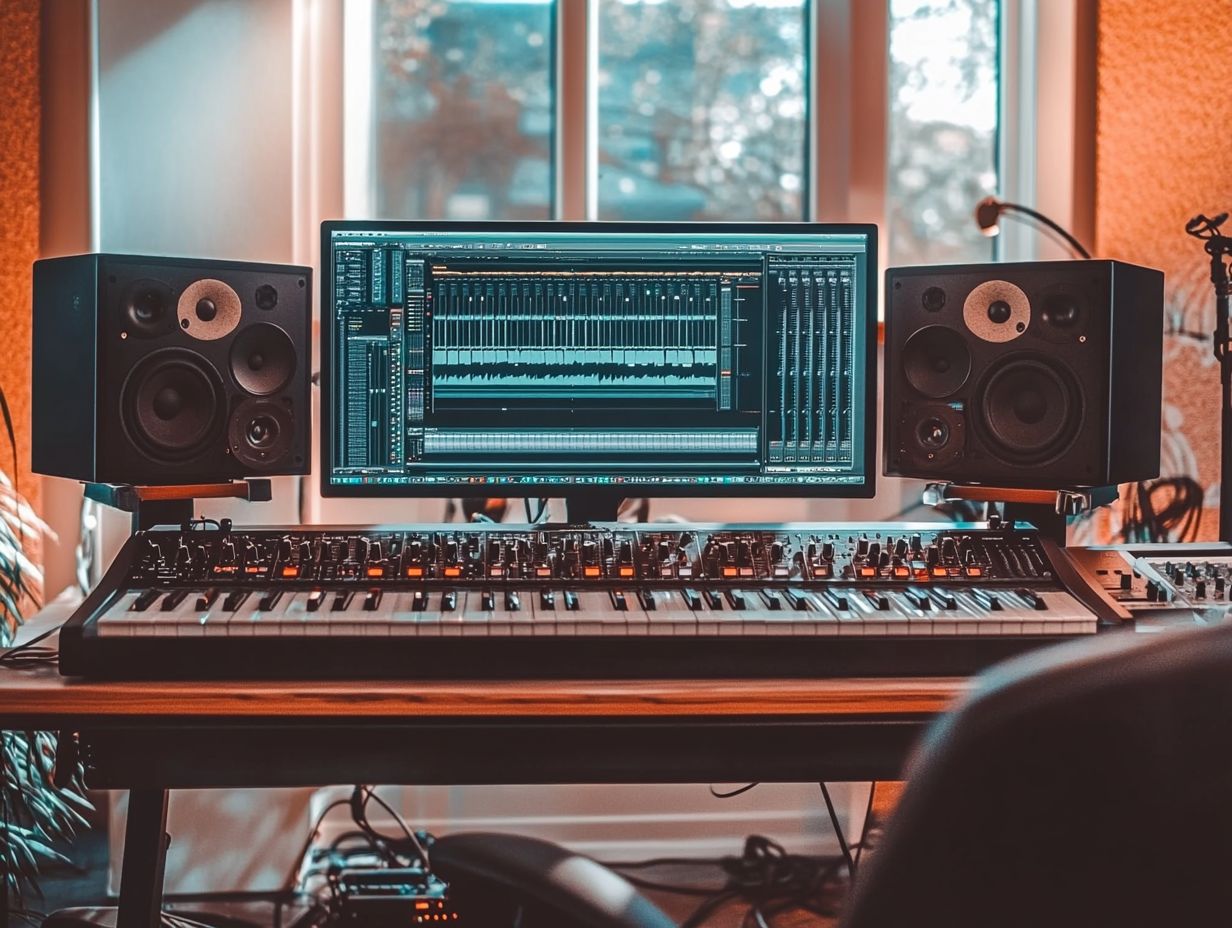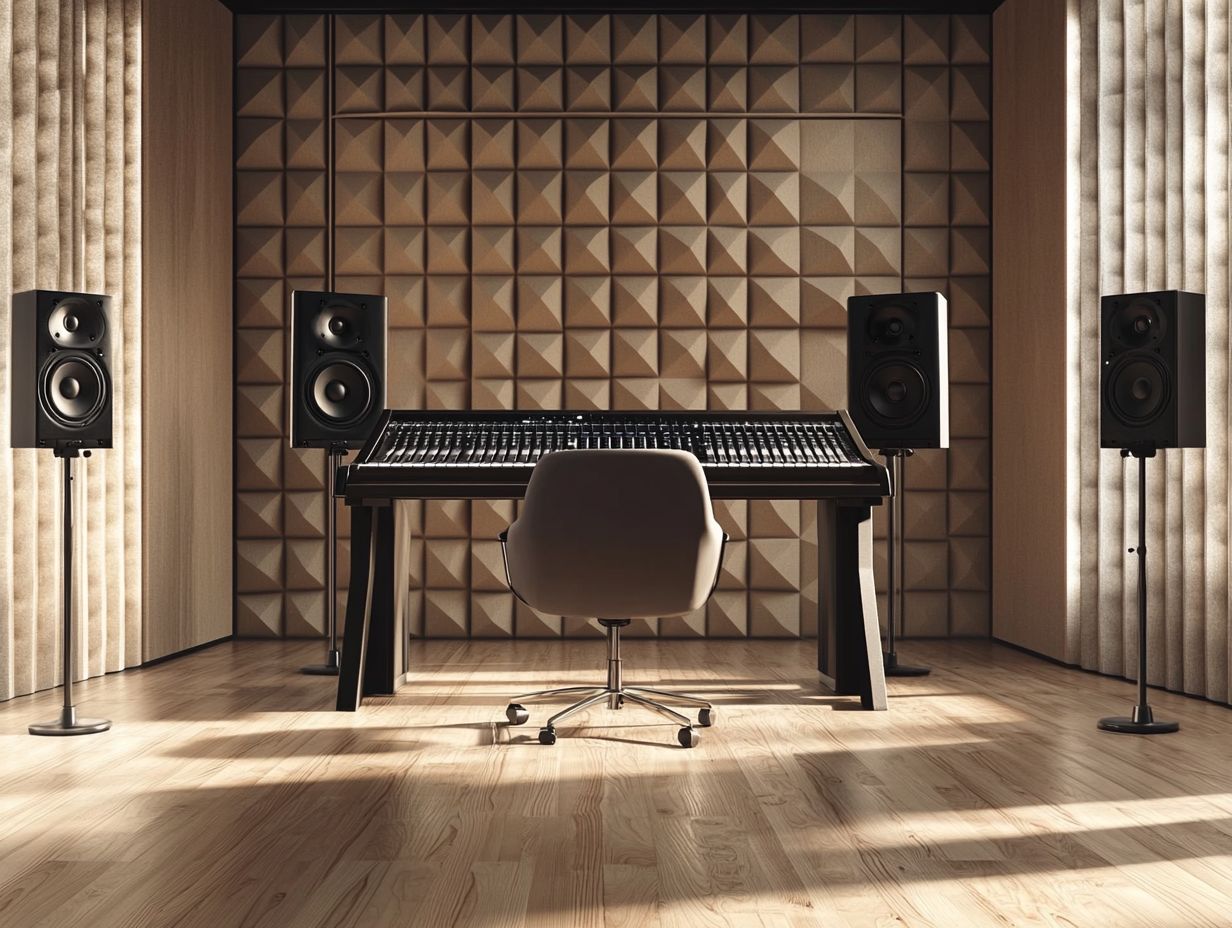The proper placement of studio monitors is essential for achieving optimal sound quality in any recording or mixing environment.
The positioning of speakers can significantly influence audio perception, impacting various aspects such as clarity and bass response.
Key factors to consider include room acoustics and speaker positioning, along with best practices for optimal placement.
Common challenges, such as bass buildup and uneven sound distribution, will also be addressed, equipping individuals with the necessary tools and techniques to achieve studio perfection.
The Importance of Proper Studio Monitor Placement

Proper placement of studio monitors is essential for achieving optimal sound quality in any audio production environment, particularly within professional studios or home studio setups.
The arrangement of studio monitors has a significant impact on the listening experience, influencing both sound balance and stereo imaging.
By understanding how monitor placement affects the soundstage, sound engineers can create an environment that enhances audio fidelity, ensuring that sound waves are reproduced accurately and without distortion.
This meticulous attention to monitor placement will lead to improved monitoring accuracy, ultimately enhancing the overall quality of audio projects.
How Placement Affects Sound Quality
The placement of studio monitors is critical in determining overall sound quality, as it significantly influences how sound waves interact with the listening environment and the listener’s position.
Proper speaker alignment is essential, as it directly affects the perceived balance of frequencies and ensures accurate sound dispersion throughout the room. When monitors are angled appropriately towards the listener, it enhances frequency response, resulting in clearer highs and more defined lows.
Furthermore, acoustic treatment within the studio can substantially enhance sound quality by absorbing unwanted reflections and minimizing standing waves. This strategic positioning, in conjunction with carefully considered acoustic elements, fosters an optimal listening environment, ultimately impacting every aspect of the audio experience, from clarity to immersion.
Factors to Consider When Placing Studio Monitors
When determining the optimal placement of studio monitors, several factors must be carefully considered to ensure optimal sound reproduction and monitoring accuracy. These factors include room acoustics, speaker positioning, reflective surfaces, and the listener’s position, all of which significantly contribute to the overall listening experience.
By comprehensively understanding the interactions among these elements, sound engineers can create a more controlled acoustic environment, thereby maximizing audio clarity and minimizing undesirable sound artifacts.
Properly addressing these considerations is essential for effective audio mixing and can significantly enhance workflow in both professional studios and home studio setups.
Room Acoustics
Room acoustics significantly influence the performance and effectiveness of studio monitors, affecting how sound waves interact within the listening environment.
When sound waves propagate through a space, they generate a complex sound field characterized by reflections that can lead to interference, particularly at specific room modes. This emphasizes the critical role of acoustic treatment in optimizing sound quality.
By employing acoustic panels and damping materials strategically, individuals can manage these reflections, thereby controlling the frequency spectrum and enhancing sound absorption. Such treatments not only mitigate unwanted echoes but also balance the tonal quality of music, resulting in a clearer and more accurate listening experience.
Consequently, the overall sound quality in recording studios or home setups is markedly improved, facilitating greater precision in mixing and mastering processes.
Speaker Positioning
Effective speaker positioning is essential for achieving an accurate soundstage and ensuring precise audio monitoring, which can significantly enhance the mixing process.
By thoughtfully considering the optimal angles and distances between the speakers and the listening position, one can establish an immersive auditory environment that facilitates clarity.
Maintaining symmetry in the setup is of paramount importance; it not only influences sound dynamics but also assists in achieving phase coherence, thereby enabling a balanced representation of audio frequencies.
The distance of the speakers from the walls should be carefully adjusted to minimize unwanted reflections that may compromise the overall mix. Proper orientation and alignment will ultimately contribute to a higher fidelity experience, allowing for more well-considered choices during the mixing phase.
Best Practices for Studio Monitor Placement

Implementing best practices for studio monitor placement can significantly enhance sound quality and monitoring accuracy, thereby benefiting audio engineers and music producers.
Key considerations include:
- Optimal positioning in relation to the listening position
- Height adjustments to ensure that the speakers are at ear level
- Strategic desk placement to reduce interference from other equipment
By adhering to these guidelines, sound professionals can improve their monitoring setup, leading to a better understanding of sound dynamics and an overall enhancement in audio clarity.
Optimal Distance from Walls and Corners
Maintaining an optimal distance from walls and corners is crucial for achieving accurate bass response and preventing sound coloration in studio monitors.
To maximize sound clarity and fidelity, both audiophiles and professionals recommend positioning these speakers at least two to three feet away from any wall or corner. This spacing allows room dimensions to play a critical role in managing bass frequencies, thereby reducing unwanted reflections that can compromise overall sound reproduction.
By adhering to these guidelines, users can expect an improvement in speaker response, resulting in a more balanced mix. Additionally, considering the geometry and size of the room can further enhance the listening experience, allowing low frequencies to resonate without overpowering other elements in the audio spectrum.
Height and Angle of Monitors
Adjusting the height and angle of studio monitors is essential for achieving an optimal listening experience, as it ensures that sound reaches the listener at ear level, facilitating accurate sound reproduction.
This positioning is critical because it affects how sound waves propagate within the room, significantly impacting sound balance and audio clarity. Improper orientation can result in an off-axis listening experience, where certain frequencies may be either exaggerated or diminished, leading to an imbalanced sonic landscape.
By tilting the monitors to the appropriate angle, listeners are better equipped to discern the nuances in their audio, enhancing detail and separation within the mix. Proper alignment of the speakers minimizes unwanted reflections from surrounding surfaces, thereby allowing for a more cohesive and immersive listening experience.
Ultimately, implementing these adjustments cultivates an environment conducive to creativity, ensuring that sound translates more faithfully.
Troubleshooting Common Placement Issues
Troubleshooting common placement issues is essential for ensuring that studio monitors deliver accurate sound and operate optimally in various listening environments.
Engineers frequently encounter challenges such as uneven sound distribution, bass buildup, and the impact of reflective surfaces, all of which can compromise audio fidelity.
Recognizing how to identify and address these concerns enables sound professionals to achieve improved monitoring accuracy and enhance their audio mixing processes.
By employing effective solutions, such as speaker isolation and proper calibration, users can optimize their monitoring setups for superior performance.
Bass Buildup and Reflections
Bass buildup resulting from reflections within a room can significantly impact the performance of studio monitors, leading to a muddy sound and inaccurate frequency response.
This phenomenon occurs when sound waves reflect off hard surfaces, amplifying certain low-frequency sounds while attenuating others. Consequently, this creates an imbalanced listening environment in which details become obscured, and overall sound quality declines.
To mitigate these challenges, the implementation of acoustic treatment can be highly effective. Strategically positioning absorbent materials and diffusers throughout the space helps to manage these reflections, resulting in a more balanced sound profile.
Additionally, optimizing the distance between the speakers and the walls can further reduce bass buildup, ensuring that sound waves disperse more evenly throughout the room.
Uneven Sound Distribution

Uneven sound distribution presents significant challenges for audio engineers, resulting in compromised monitoring accuracy and an imperfect mix.
This issue frequently arises from factors such as improper speaker alignment and suboptimal listener positioning within a given space. When speakers are misaligned or when the listener occupies a position that amplifies certain frequencies while attenuating others, the auditory experience can become unbalanced.
To mitigate these concerns, it is essential to employ best practices, such as utilizing phase coherence techniques, which ensure that sound waves reach the listener’s ears simultaneously, thereby minimizing phase cancellation effects.
Additionally, sound monitoring techniques, including the use of measurement microphones and acoustic analysis software, provide valuable insights into room dynamics. This information enables engineers to make necessary adjustments, facilitating the creation of an optimal listening environment.
Tools and Techniques for Accurate Placement
The utilization of appropriate tools and techniques for precise monitor placement is essential for achieving optimal sound quality and performance in any audio project.
Measurement Tools
Measurement tools are essential for the precise placement of studio monitors, allowing sound engineers to evaluate sound waves and frequency response within the listening environment.
Instruments such as room analyzers and calibrated microphones are critical for identifying acoustic anomalies and enabling professionals to make informed adjustments. By employing software that visualizes sound frequency curves, engineers can accurately identify areas where sound may be disproportionately emphasized or attenuated, ensuring that monitors are positioned for optimal performance.
Additionally, tools like sound pressure level (SPL) meters are used to assess sound pressure levels, ensuring that volume levels are appropriate for the acoustic space. This comprehensive approach to measurement not only enhances audio clarity but also improves the overall listening experience, facilitating effective collaboration between technicians and artists.
Acoustic Treatment Options
Exploring various acoustic treatment options can significantly enhance the sound quality of a recording space by minimizing the effects of reflective surfaces and improving overall sound isolation.
By incorporating acoustic panels, bass traps, and specialized damping materials, individuals can customize their environments to facilitate improved sound dynamics.
Acoustic panels, when strategically placed on walls, absorb mid to high frequencies, thereby reducing echo and creating a clearer auditory experience. In addition, bass traps installed in corners effectively manage low-frequency sound, preventing muddiness and ensuring a more defined speaker response.
Collectively, these treatments can transform a standard room into a studio-like environment, enabling musicians and producers to capture and reproduce sound with exceptional precision and clarity.
Frequently Asked Questions
What are some tips for properly placing studio monitors?

1. Place the monitors at ear level: The ideal placement for studio monitors is at ear level, so that the sound reaches your ears directly without any interference or distortion.
2. Keep them away from walls: Avoid placing the monitors too close to walls, as this can cause bass buildup and affect the accuracy of the sound.
3. Use a triangle setup: Position the two monitors and your listening position in a triangle formation, with equal distance between each point.
4. Avoid corners: Placing the monitors in corners can also cause bass buildup and affect the clarity of the sound.
5. Consider acoustic treatment: If your room has poor acoustics, consider using acoustic treatment to improve the sound quality and reduce unwanted reflections.
6. Use a monitor isolation pad: To further improve the sound quality, use monitor isolation pads to decouple the monitors from your desk or stands and eliminate any vibrations.
Should I use a subwoofer with my studio monitors?
It depends on your personal preference and the type of music you produce. If you work with bass-heavy genres, a subwoofer can help you accurately hear and mix the low frequencies. However, if your room is not acoustically treated, a subwoofer can often cause more harm than good.
Can I place my studio monitors on a bookshelf?
It is not recommended to place studio monitors on a bookshelf, as the uneven surface and potential vibrations can affect the accuracy of the sound. It is best to invest in proper monitor stands or use a monitor isolation pad to decouple the monitors from the surface.
What is the ideal distance between my studio monitors?
The ideal distance between studio monitors varies depending on the size and type of the monitors. As a general rule, aim for a distance of 3-4 feet between the monitors and your listening position for a balanced sound.
Can I use headphones instead of studio monitors?
Headphones can be a helpful tool for mixing, but they should not be used as a replacement for studio monitors. Headphones can often exaggerate certain frequencies and can cause listening fatigue, making it difficult to accurately mix your music.
How can I test the placement of my studio monitors?
The best way to test the placement of your studio monitors is by using reference tracks. Play a well-mixed track that you are familiar with and listen to how it sounds in your room. If the sound is clear, balanced, and without any major dips or peaks in certain frequencies, then your placement is likely correct. If not, try adjusting the placement or using acoustic treatment to improve the sound.


 Master Your Drumming: A Guide to Choosing the Right Drumsticks for Different Playing Styles
Master Your Drumming: A Guide to Choosing the Right Drumsticks for Different Playing Styles